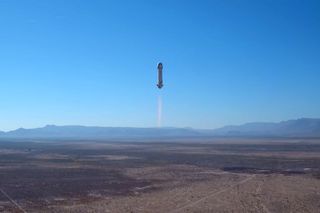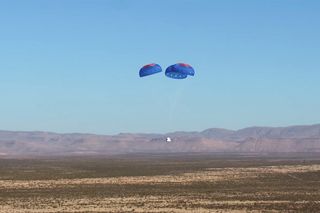Watch Blue Origin's New Shepard 2.0 Spacecraft Soar in 1st Test Flight
Blue Origin took its new reusable spaceship out for its first spin yesterday (Dec. 12), and you can watch the test flight's highlights in a dramatic new video.
The video shows the next-gen New Shepard rocket-capsule combo, which Blue Origin is developing to carry people and payloads on trips to suborbital space, lift off from the company's West Texas launch site yesterday at 11:59 a.m. EST (1659 GMT, 10:59 a.m. local Texas time).
Both the booster and the capsule reached a maximum altitude of about 62 miles (99 kilometers) before coming back down to Earth, Blue Origin representatives said in a test-flight fact sheet. The rocket made a controlled, vertical touchdown on a designated landing pad, whereas the capsule — and its instrument-laden dummy passenger, "Mannequin Skywalker" — dropped down under parachutes, puffing up a plume of West Texas dirt when it hit the ground. [In Photos: Blue Origin's New Shepard 2.0 Aces Maiden Test Flight]

The capsule's landing brought the uncrewed test flight to an end, 10 minutes and 6 seconds after liftoff, according to the fact sheet provided by Blue Origin, the Kent, Washington-based company founded in 2000 by billionaire entrepreneur Jeff Bezos.
A few other tidbits from the fact sheet: The booster reached a top speed of Mach 2.94 during its ascent and Mach 3.74 during its descent but was traveling a mere 6.75 mph (10.9 km/h) when it touched down. (Mach 1 is the speed of sound — about 767 mph, or 1,235 km/h, at room temperature.)
The capsule hit the ground at just 1 mph (1.6 km/h), according to the new video.

"Today's flight of New Shepard was a tremendous success," Blue Origin CEO Bob Smith said in a statement. "It marks the inaugural flight of our next-generation Crew Capsule as we continue step-by-step progress in our test flight program. Congratulations to the entire Blue Origin team on a job well done and to our payload customers that gathered important data on the suborbital environment. Gradatim Ferociter."
Get the Space.com Newsletter
Breaking space news, the latest updates on rocket launches, skywatching events and more!
"Gradatim Ferociter" is the motto of Blue Origin. It means "Step by Step, Ferociously," in Latin.
On yesterday's flight, the crew capsule carried 12 payloads from a variety of customers, including a Colorado middle school, which sent up student artwork and an Arduino Nano circuit board with a student-programmed sensor package.

The unpiloted New Shepard capsule can accommodate up to six passengers, who will see the curvature of Earth against the blackness of space and experience a brief period of weightlessness during their suborbital trips. The new version of the craft has windows that measure 2.4 feet wide by 3.6 feet tall (0.7 by 1.1 meters) — the largest windows ever to fly in space, according to Blue Origin representatives.
Blue Origin aims to begin commercial operations with the New Shepard system soon, perhaps as early as 2018. The company has not disclosed how much a seat aboard the vehicle will cost.
Yesterday's test flight marked the seventh overall for New Shepard variants and the first one in more than a year. The previous version of the vehicle pulled off five straight successful flights from November 2015 to October 2016.
Follow Mike Wall on Twitter @michaeldwall and Google+. Follow us @Spacedotcom, Facebook or Google+. Originally published on Space.com.
Join our Space Forums to keep talking space on the latest missions, night sky and more! And if you have a news tip, correction or comment, let us know at: community@space.com.

Michael Wall is a Senior Space Writer with Space.com and joined the team in 2010. He primarily covers exoplanets, spaceflight and military space, but has been known to dabble in the space art beat. His book about the search for alien life, "Out There," was published on Nov. 13, 2018. Before becoming a science writer, Michael worked as a herpetologist and wildlife biologist. He has a Ph.D. in evolutionary biology from the University of Sydney, Australia, a bachelor's degree from the University of Arizona, and a graduate certificate in science writing from the University of California, Santa Cruz. To find out what his latest project is, you can follow Michael on Twitter.